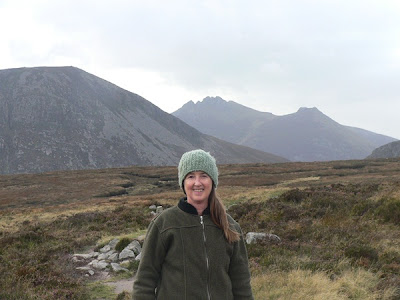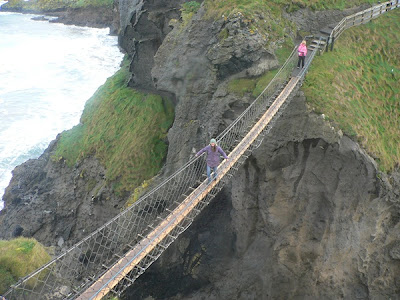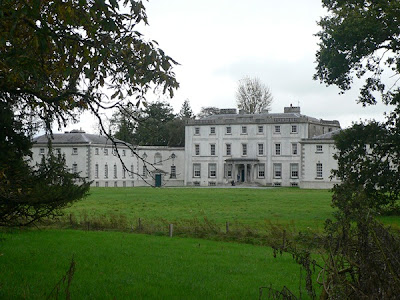So far it's been mild, despite predictions that we were in for another arctic winter like the last two years. The temperatures have mainly been in the 40's and low 50's F with a few clear frosty days early in December. Mostly we've had grey brooding skies, rain and very short days - sunrise now is not till 9 am and the sun sets at 4:30.
At the end of October we drove north about 4 hours to County Sligo for the Sligo Live music festival - lots of free music of all genres in pubs and cafes throughout the city plus a fantastic solo concert by Elvis Costello at the local college (one of our musical favorites that we've been wanting to see for a long while). It was pretty wet most of the weekend so not very good for hillwalking in the beautiful Sligo mountains. We went to an interesting historical site with many prehistoric stone tombs and a huge mound of stones called a barrow tomb (the long mound in the distance in these two photos). This one pre-dates the pyramids, and like the pyramids it was an impressive tomb for someone of the highest rank.
Archaeologists opened up an entryway into the stone mound which is now reinforced with wire mesh so you can walk into the center of the mound.
In the very center of the mound there was a stone dolmen that once held human bones inside.

We walked to the top of a small mountain that has another barrow mound at the very top that is supposed to be tomb of Queen Maeve of Ulster. You can get an idea of the size by this picture of me standing by the base of the mound. It was a misty day and kind of spooky around all these ancient tombs, especially as that day was Samhain (pronounced 'sow-en') the pagan festival day when the spirits of the dead walk the earth (and the origins for Halloween).
On our way back to Clare we took a side trip to the Céide Fields in County Mayo, the oldest known field
systems in the world, over five and a half millennia old. The
remains of stone field walls, houses and megalithic tombs
are preserved beneath a blanket of peat over several square
miles and show how developed and sophisticated the agricultural system was then. There is a very good interpretive center and the guided tour around the site brought to life the community that lived and farmed in this region over 5,000 years ago.
I was also surprised to learn how low-tech is their method for locating the ancient walls of houses and fields that have been buried under the blanket bog. They simply insert thin rods into the bog about a foot apart in a straight line until they hit rocks down below, then they can see the locations of walls below from the profile of the rods. The guide said that modern sensoring equipment doesn't work in these wet boggy soils.
Sea cliffs near the Ceide Fields in County Mayo.
A County Mayo lough
Back home in Scariff we've been relatively quiet. In November we were cleaning up the veg garden and planting cover crops in the outdoor beds and salad greens, spring onions and broad beans in the polytunnel.

The Scariff Community Garden held a Harvest Festival and I entered this zucchini into the funny vegetable contest and won first place!
Notice the wire rim glasses and brown beard and moustache - remind you of anyone you know?
Our dogs Woody and Oscar are best friends and like to squeeze into the same comfy chair together.
In November we took the dogs for a walk through some nearby hills and bogs to a lake.
In December we had a dusting of snow and the dogs loved playing in it.
Trad session at our Thanksgiving party

























































